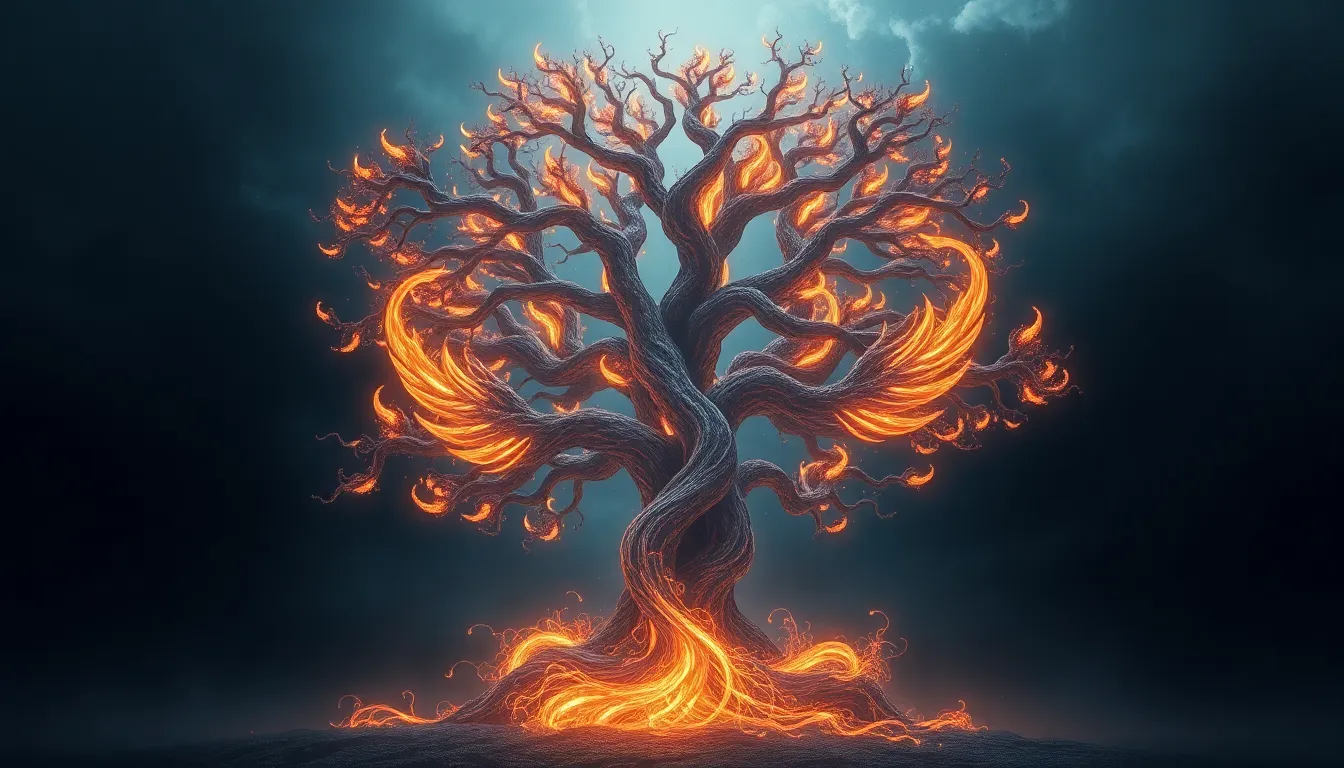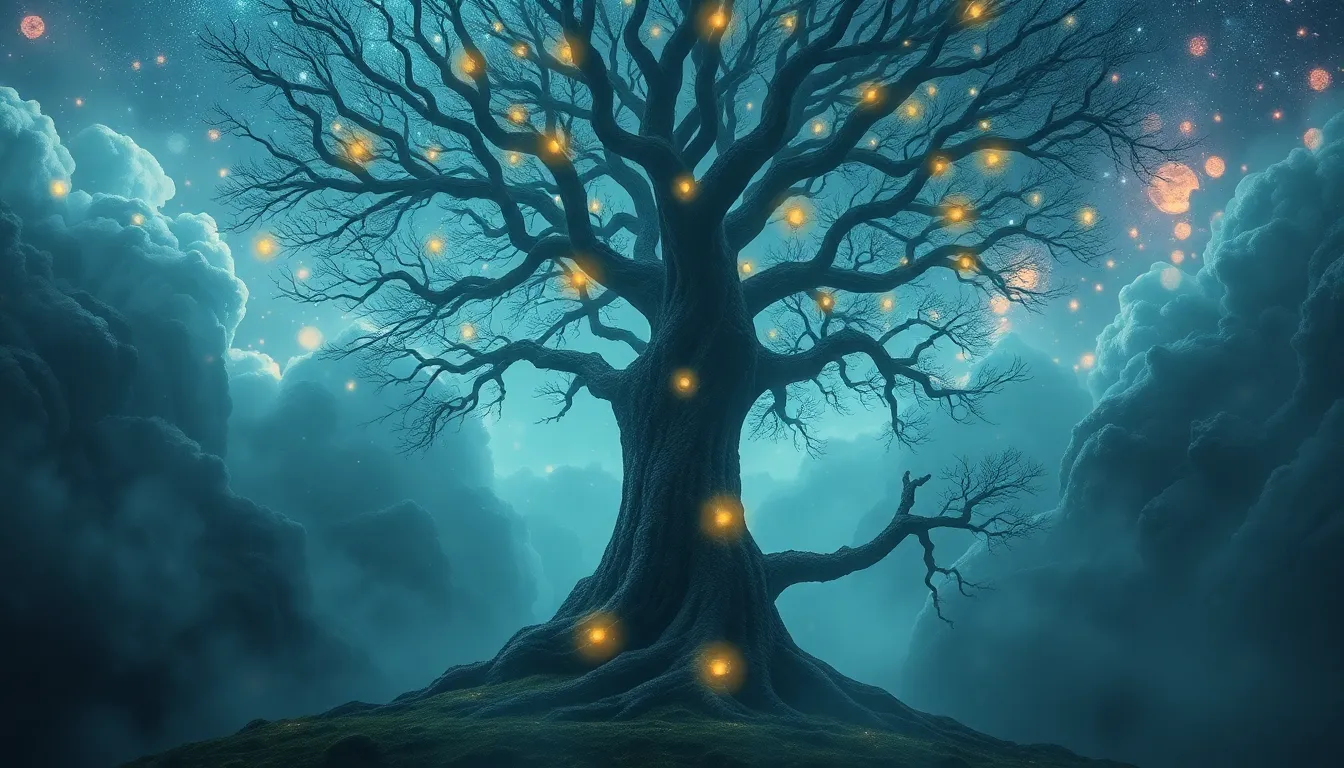The Tree of the Phoenix: Myths of Rebirth and Renewal
I. Introduction
The Tree of the Phoenix is a powerful symbol that intertwines the concepts of rebirth and renewal, representing the transformative power of life and death. This mythical tree is often depicted as a vibrant, flourishing entity, nurturing the cycles of life as it stands tall and resilient. Throughout history, the themes of rebirth and renewal have held significant importance across various cultures, serving as a reminder of life’s cyclical nature and the potential for growth after adversity.
This article will explore the rich tapestry of myths surrounding the Tree of the Phoenix, beginning with the symbolism of the Phoenix in mythology, delving into the universal motif of the Tree of Life, and analyzing their intersection. We will also examine cultural variations of the Phoenix myth, modern interpretations, psychological perspectives, rituals of renewal, and the environmental symbolism associated with this legendary creature. Finally, the article will conclude with reflections on the enduring legacy of the Phoenix myth.
II. The Symbolism of the Phoenix in Mythology
The Phoenix is a mythical bird that has captured the imagination of cultures worldwide. Its origins can be traced back to ancient civilizations, with each culture attributing different meanings and stories to this fiery creature.
- Egyptian Mythology: In ancient Egypt, the Phoenix, known as the Bennu, was associated with the sun and creation. It was believed to rise from its ashes each morning, symbolizing renewal.
- Greek Mythology: The Greeks depicted the Phoenix as a bird that lived for hundreds of years before consuming itself in flames, only to emerge reborn from the ashes.
- Chinese Mythology: In China, the Fenghuang represents virtue and grace, embodying the harmony of yin and yang.
Common themes associated with the Phoenix include:
- Transformation and change
- Resilience in the face of destruction
- The cyclical nature of life
The Phoenix serves as a powerful symbol of transformation, illustrating the potential for renewal and rebirth after periods of hardship or loss.
III. The Tree of Life: A Universal Motif
The Tree of Life is another profound symbol found across various cultures, representing growth, strength, and interconnectedness. It is often viewed as a sacred entity that nurtures life and sustains the balance of nature.
Significance of the Tree of Life includes:
- Connection between all living beings
- Symbol of wisdom and knowledge
- Representation of fertility and renewal
The Tree of Life is intricately linked to the concept of rebirth. Many cultures view it as a source of life, where new beginnings sprout from the roots of the past. For instance, in Norse mythology, Yggdrasil, the World Tree, connects the nine realms and signifies the cycle of life, death, and rebirth.
Comparative analysis reveals that while the specifics may differ, the underlying message of the Tree of Life as a symbol of renewal resonates universally.
IV. The Intersection of the Phoenix and the Tree of Life
The intersection of the Phoenix and the Tree of Life offers a compelling narrative of regeneration and hope. Both symbols illustrate the theme of rebirth, with the Phoenix rising from its ashes and the Tree of Life continuously bearing fruit.
Myths that combine both elements often portray the Phoenix as a guardian of the Tree of Life, emphasizing the importance of renewal in the cycle of existence. Artistic representations, such as paintings and sculptures, frequently depict the Tree of the Phoenix, showcasing the vibrant colors and dynamic forms that embody the essence of life and rebirth.
V. Cultural Variations of the Phoenix Myth
The Phoenix myth has evolved through various cultures, each adding unique layers of meaning to this powerful symbol. Key cultural interpretations include:
- Ancient Egyptian Mythology: The Bennu bird, linked to the sun god Ra, was believed to represent resurrection and the cyclical nature of life.
- Persian Mythology: The Simurgh is a benevolent, mythical bird that symbolizes wisdom and healing, often associated with the concept of rebirth.
- Eastern Mythology: In Chinese culture, the Fenghuang is a symbol of high virtue and grace, often associated with the Empress and representing prosperity.
Each of these cultural variations highlights the universal themes of rebirth, resilience, and the transformative power of nature.
VI. Modern Interpretations of the Phoenix Myth
In contemporary literature and media, the Phoenix continues to serve as a potent symbol of rebirth and renewal. Authors and filmmakers often utilize the Phoenix myth to explore themes of personal growth and transformation.
Examples of modern interpretations include:
- Literary works that depict characters overcoming adversity and emerging stronger.
- Films that showcase protagonists who rise from failure to success, mirroring the journey of the Phoenix.
Additionally, the Phoenix has become a popular symbol in modern spirituality, representing the idea of personal transformation and the ability to rise above challenges in life.
VII. Psychological Perspectives on Rebirth and Renewal
From a psychological standpoint, the Phoenix serves as a metaphor for personal growth and transformation. The journey of the Phoenix can be likened to a person’s journey through trauma, loss, and eventual recovery.
Key psychological theories related to transformation include:
- Jungian archetypes, where the Phoenix embodies the archetype of the Hero, who faces trials and emerges renewed.
- Post-traumatic growth, highlighting how individuals can find new meaning and strength after adversity.
Case studies of individuals embodying the Phoenix archetype often reveal profound stories of resilience, illustrating the capacity for change and renewal within the human experience.
VIII. Rituals and Practices of Renewal
Across cultures, rituals celebrating rebirth and renewal are integral to community identity and spiritual practice. These ceremonies often reflect the themes embodied by the Phoenix and the Tree of Life.
Examples include:
- Spring festivals that celebrate the return of life after winter.
- Rituals of purification and new beginnings in various spiritual traditions.
Modern practices inspired by the Phoenix myth often involve personal reflection, goal-setting, and community gatherings that emphasize collective renewal. Storytelling plays a vital role in these cultural renewals, passing down myths that inspire and unite communities.
IX. Environmental Symbolism: The Phoenix and Ecological Renewal
In recent years, the Phoenix has emerged as a symbol for environmental recovery and resilience. The myth of the Phoenix resonates with narratives of ecological restoration and the healing of our planet.
Key points include:
- The Phoenix symbolizes nature’s ability to recover from destruction, as seen in wildfires that lead to new growth.
- Myths of nature’s resilience highlight the interconnectedness of life and the importance of preserving ecosystems.
Case studies of ecological restoration projects often reflect the Phoenix myth, showcasing how communities can come together to rejuvenate their environments, embodying the spirit of rebirth.
X. Conclusion
The Tree of the Phoenix serves as a powerful symbol of rebirth and renewal, reflecting humanity’s universal desire for transformation and growth. Through various cultural lenses, the myths surrounding the Phoenix and the Tree of Life remind us of the cyclical nature of existence and the potential for renewal after adversity.
As we reflect on the enduring legacy of the Phoenix myth, we are reminded of the resilience inherent in both nature and the human spirit, inspiring us to embrace our own journeys of rebirth and renewal.



